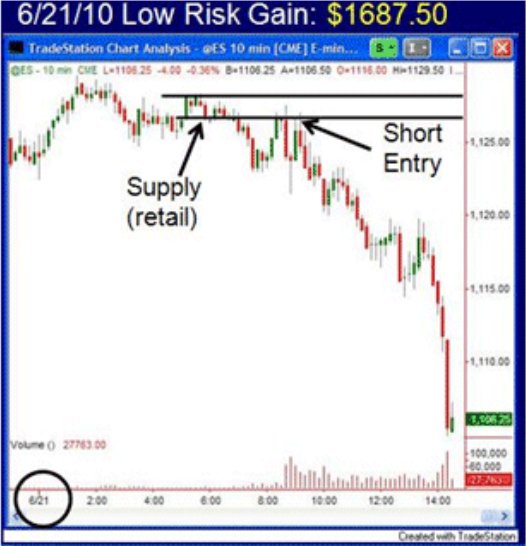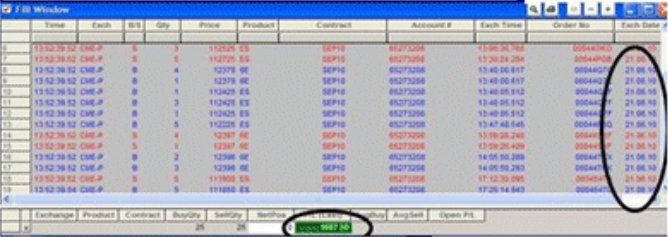I started my career on the floor of the Chicago Mercantile Exchange facilitating institutional order flow. This means taking large buy and sell orders from banks, institutions, money managers, hedge funds, and more, paying close attention to market price, and then making sure those orders get executed and filled at the proper prices. I started in the currency quadrant and was specifically responsible for the Japanese Yen, Canadian Dollar, British Pound, Deutsch Mark, and Swiss Franc markets. The highest volume and most volatile market of this group back then was the Japanese Yen, so that's where much of my focus was.
One of the main reasons for the high volume and volatility was the Bank of Japan (BOJ) as they were very active in this market. As you may know, Japan has been primarily an export economy which means they have desired a weak currency (Yen). A weak (cheap) currency makes their goods and products attractive to the rest of the world. Often, because of a strong economy due to strong export sales, the Japanese Yen would strengthen and the Japanese government and BOJ would not like this. Their solution almost always was to "Intervene" in the currency market to help weaken the Yen. They would put hundreds of millions to work in the market, selling the Yen against other major currencies to drive down price of the Yen. I witnessed this and was a part of it many times. They would surprise the market to achieve the biggest effect, news wires would start informing the world that the BOJ was intervening to weaken the Yen, and this would cause many traders to exit long positions and sell. The outcome of this intervention was always the same, but it may not be what you think it is.
What would happen quickly was the value of the Yen would decline to levels the BOJ was aiming for which is no surprise. However, soon after, not only would the Yen rally back to pre-intervention levels, but it would then rally a ton more. I found this fascinating and realized one of the most important lessons from my time on the exchange floor: Intervention in free markets never works. What is most interesting is that the BOJ and other central banks have the power to print money and they can't even control a truly free market. The "invisible hand" always brought market price to where it should be, not where someone wanted it to be, even with the ability to print money.
There are many types of government and central bank intervention and to be honest with you, I have NEVER seen it work for more than a short period of time. In fact, from my experience, the opposite price action occurs from the goal of the intervention. For example, take the pre-March 2009 S&P low downtrend in the global markets. During this time, government "bailouts" were the theme and seemed to happen every other month. In the Extended Learning Track (XLT) online training program, I created a rule in the XLT that every time a bailout was announced, students were to look for a supply (resistance) level in the S&P and get ready to sell short. Sure enough, the market would rally on the bailout news, reach a supply level, and decline.
This line of thinking for me has been very profitable over the years. A recent example happened on June 21, 2010, just a few weeks ago. Early in the morning US time, a news headline was released: "US equities rally up on Yuan intervention." China suggested that it was going to ease its currency's peg to the US Dollar and allow it to float more freely. As you can see in that news release, the global markets gapped up and rallied strongly on that news. All I had to see was the word "intervention" and that was a sell signal for me.
"US equities rally up on Yuan intervention"
Mon, Jun 21 2010, 14:18 GMT
FXStreet
FXstreet.com (Barcelona) - US benchmark indices tracked the wide-spread positive tone seen in financial markets, as investors embarked upon a quest for higher yielding corners across the market place. The aggressive shift targeting upside levels is primarily attributed to the PBoC's vow to unpeg tight oscillations between the Renminbi and the US Dollar. The investing community rose its global outlook on the basis that the action taken by Chinese's officials will likely rise demand for exports and commodities.The Dow Jones Industrial Average logged in substantial gains through the first hour of trading as the index jumped above 1.30%. The Nasdaq Composite surged by more than 1% while the S&P 500 rose by 1.50%.


The chart above is a small time frame chart of the S&P Futures. To the left, but NOT seen on the chart, is a huge gap up in price. As soon as I saw a little supply level form, it was time to sell short and bet on a downside move in the market. The reason is threefold. First, the cause of the rally was novice buying due to the intervention news. Second, price had reached a level where the chart clearly suggested supply exceeded demand which meant the shorting opportunity was low risk. Third, the gap up in price meant that there was a clear, large profit margin below as in the gap, there is no demand to stop price from falling. For more information on this last point, see my recent article entitled: "Motion Into Mass." While the gain on this trade was small, the risk / reward opportunity was very ideal.
Remember, to me, "intervention" means someone is trying to artificially alter free market price and this is not possible in my opinion. The reason the opposite desired price action ultimately occurs is because the act of intervention itself is a clear signal that something is wrong or broken in the market. It is actually a tip that while price may move in one direction initially, the big move is ultimately in the opposite direction. Those that understand this and can quantify supply and demand in markets enjoy huge opportunity when intervention occurs. They are given this opportunity by those who don't understand.
One of the main reasons for the high volume and volatility was the Bank of Japan (BOJ) as they were very active in this market. As you may know, Japan has been primarily an export economy which means they have desired a weak currency (Yen). A weak (cheap) currency makes their goods and products attractive to the rest of the world. Often, because of a strong economy due to strong export sales, the Japanese Yen would strengthen and the Japanese government and BOJ would not like this. Their solution almost always was to "Intervene" in the currency market to help weaken the Yen. They would put hundreds of millions to work in the market, selling the Yen against other major currencies to drive down price of the Yen. I witnessed this and was a part of it many times. They would surprise the market to achieve the biggest effect, news wires would start informing the world that the BOJ was intervening to weaken the Yen, and this would cause many traders to exit long positions and sell. The outcome of this intervention was always the same, but it may not be what you think it is.
What would happen quickly was the value of the Yen would decline to levels the BOJ was aiming for which is no surprise. However, soon after, not only would the Yen rally back to pre-intervention levels, but it would then rally a ton more. I found this fascinating and realized one of the most important lessons from my time on the exchange floor: Intervention in free markets never works. What is most interesting is that the BOJ and other central banks have the power to print money and they can't even control a truly free market. The "invisible hand" always brought market price to where it should be, not where someone wanted it to be, even with the ability to print money.
There are many types of government and central bank intervention and to be honest with you, I have NEVER seen it work for more than a short period of time. In fact, from my experience, the opposite price action occurs from the goal of the intervention. For example, take the pre-March 2009 S&P low downtrend in the global markets. During this time, government "bailouts" were the theme and seemed to happen every other month. In the Extended Learning Track (XLT) online training program, I created a rule in the XLT that every time a bailout was announced, students were to look for a supply (resistance) level in the S&P and get ready to sell short. Sure enough, the market would rally on the bailout news, reach a supply level, and decline.
This line of thinking for me has been very profitable over the years. A recent example happened on June 21, 2010, just a few weeks ago. Early in the morning US time, a news headline was released: "US equities rally up on Yuan intervention." China suggested that it was going to ease its currency's peg to the US Dollar and allow it to float more freely. As you can see in that news release, the global markets gapped up and rallied strongly on that news. All I had to see was the word "intervention" and that was a sell signal for me.
"US equities rally up on Yuan intervention"
Mon, Jun 21 2010, 14:18 GMT
FXStreet
FXstreet.com (Barcelona) - US benchmark indices tracked the wide-spread positive tone seen in financial markets, as investors embarked upon a quest for higher yielding corners across the market place. The aggressive shift targeting upside levels is primarily attributed to the PBoC's vow to unpeg tight oscillations between the Renminbi and the US Dollar. The investing community rose its global outlook on the basis that the action taken by Chinese's officials will likely rise demand for exports and commodities.The Dow Jones Industrial Average logged in substantial gains through the first hour of trading as the index jumped above 1.30%. The Nasdaq Composite surged by more than 1% while the S&P 500 rose by 1.50%.


The chart above is a small time frame chart of the S&P Futures. To the left, but NOT seen on the chart, is a huge gap up in price. As soon as I saw a little supply level form, it was time to sell short and bet on a downside move in the market. The reason is threefold. First, the cause of the rally was novice buying due to the intervention news. Second, price had reached a level where the chart clearly suggested supply exceeded demand which meant the shorting opportunity was low risk. Third, the gap up in price meant that there was a clear, large profit margin below as in the gap, there is no demand to stop price from falling. For more information on this last point, see my recent article entitled: "Motion Into Mass." While the gain on this trade was small, the risk / reward opportunity was very ideal.
Remember, to me, "intervention" means someone is trying to artificially alter free market price and this is not possible in my opinion. The reason the opposite desired price action ultimately occurs is because the act of intervention itself is a clear signal that something is wrong or broken in the market. It is actually a tip that while price may move in one direction initially, the big move is ultimately in the opposite direction. Those that understand this and can quantify supply and demand in markets enjoy huge opportunity when intervention occurs. They are given this opportunity by those who don't understand.
Last edited by a moderator:
